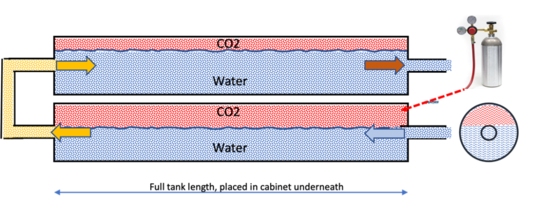2
22802
Guest
For Info from Moderation Team: UKAPS is not against innovation in the hobby or new approaches and ideas on how to do things, CO2 is one that most struggle with and any new idea is viable if presented in the right manner, this thread will be closed and remain here, unless the original member contacts UKAPS and asks for it to be removed. The said member was banned because of constant flooding of the forum with misleading and contradicting information for new members, and also when people did not reply to this post went and flooded the entire forum instead, when approached to curtail on this behaviour, refused to see our point of view and carried on regardless, eventually we had no choice due to the wording of said members replies across the forum and mass PM's playing the victim!
Original post from here:
Conventional CO2 reactors are basically water columns with bubbles in a flow. The bubbles create a maximum surface area from CO2 to water, necessary for enough CO2 to be absorbed. CO2 reactors work fine, but need careful optimisation (dimensions, adjustable flow and bypass) to work well (no noise, not too much filter flow reduction, no bubbles escaping into tank, sufficient CO2 absorption capacity).
Especially for tanks larger than a few hundred litres, it becomes more challenging to create a good CO2 reactor setup.
CO2 Spray Bar is simpler than conventional CO2 reactors, and less complicated to set up and operate. It uses a laminar water flow under a pocket of CO2 gas to enable the CO2 absorption. It is an in-tank solution - for some this is great while others may not like it.
For really large tanks the dimensions of the Spray Bar could become an issue, and not look good in the tank.
My CO2 Spray Bar has a cross section of 1 Inch, 2.5 cm, and is 80 cm long. This is more than enough for my 250 litre tank, as it drops pH from outgassed water by approximately 1.5-1.6 with a reasonable tank surface agitation.
Now that I know how much absorption surface area I need for my tank, how would that scale up to larger tanks?
I took my experience from the CO2 Spray Bar, and came up with an horizontal CO2 reactor that applies the same principles. This horizontal reactor would have the full tank length, and be installed in the cabinet underneath the tank

This horizontal CO2 reactor obviously has no bubbles floating in a moving water column, does not care how much the water flow is, will be perfectly silent, will not release bubbles in the tank, and is of course not visible in the tank. As I will illustrate below it is straightforward to have it inject tanks with volumes of thousands of litres.
We can also design a multi stage horizontal reactor. When the lower reactor gets full with CO2, its maximum capacity reached, bubbles of CO2 will start to escape to the upper reactor, gradually fill it and boost the CO2 absorption with the second stage active.

The multi stage can be useful for really big tanks (thousands of litres), or when it is advantageous to work with smaller pipe diameters, while still having sufficient capacity.
I used @durb992000 tank, 2.300 litres as an example to do some estimations. I know what CO2 Spray Bar is good enough for a 1.5 pH drop in my 250 l tank, and estimate how the horizontal reactor needs to be scaled up for this 2.300 l tank.
First some basics, to understand how to scale up a reactor, so that it works for a larger tank.
When CO2 has stabilised during the photoperiod, most of the injected CO2 will be outgassed to the surface and ambient air, and a minor part will be taken by plants. We therefore take the assumption that steady state CO2 injection is proportional to the surface area (length*width) of the tank.
Therefore the surface area of a CO2 Spray Bar or Horizontal Reactor scales up with (tank length * width) for steady state during the photo period.
When we start injecting a fully outgassed tank, obviously the amount of CO2 needed in the process is proportional to the tank volume (length * width * height). However, this is not a fair assumption for a normal day ramp up, as the tank still has residual CO2 from the previous day. In fact, the amount of CO2 outgassed during the night is proportional to the surface area, NOT to the tank volume.
Therefore for a morning ramp up with CO2 Spray Bar or Horizontal Reactor, we need to scale the dimensions proportional to the surface area (length*width) of the tank.
Now let’s take one big 2.300 l tank as an example, and compare with 248 l 22802 tank. Keep in mind , a 1 inch full tank length CO2 Spray Bar on 22802 tank is good for 1.5-1.6 pH drop.

BigTank has a volume 9.6 times 22802 , and as surface area 5.8 times.
When we always use the full tank length for our reactor, the diameter should not be scaled up proportional to volume (length*width*depth), but rather with the width*height ratio (4.5).
Similar, when using full tank length and proportional to surface area, we can use width ratio (2.7) as the scaling factor.
So if we use a standard 4 inch plumbing/sewer pipe as the main reactor for BigTank, we are exceeding the 2.7 ratio that would be required for a comparable steady state operation to 22802 (1.5 pH drop), and most likely a similar ramp up time in the morning (I use 3 hours to be on the safe side)
In summary, a 4 inch horizontal reactor installed in the cabinet over the full tank length is expected to effortlessly power a 2.300 l tank. Alternatively use a thinner 2 inch reactor, and a double multi stage reactor configuration.
Not much can go wrong with a horizontal reactor. No optimizations, adjustment, no noise and can it be made very powerful indeed. And it standard plumbing materials.
Finally, for a real big tank I would always use a CO2/pH controller, for stability and for CO2 savings (less need for a strong surface agitation and outgassing).
Original post from here:
Conventional CO2 reactors are basically water columns with bubbles in a flow. The bubbles create a maximum surface area from CO2 to water, necessary for enough CO2 to be absorbed. CO2 reactors work fine, but need careful optimisation (dimensions, adjustable flow and bypass) to work well (no noise, not too much filter flow reduction, no bubbles escaping into tank, sufficient CO2 absorption capacity).
Especially for tanks larger than a few hundred litres, it becomes more challenging to create a good CO2 reactor setup.
CO2 Spray Bar is simpler than conventional CO2 reactors, and less complicated to set up and operate. It uses a laminar water flow under a pocket of CO2 gas to enable the CO2 absorption. It is an in-tank solution - for some this is great while others may not like it.
For really large tanks the dimensions of the Spray Bar could become an issue, and not look good in the tank.
My CO2 Spray Bar has a cross section of 1 Inch, 2.5 cm, and is 80 cm long. This is more than enough for my 250 litre tank, as it drops pH from outgassed water by approximately 1.5-1.6 with a reasonable tank surface agitation.
Now that I know how much absorption surface area I need for my tank, how would that scale up to larger tanks?
I took my experience from the CO2 Spray Bar, and came up with an horizontal CO2 reactor that applies the same principles. This horizontal reactor would have the full tank length, and be installed in the cabinet underneath the tank

This horizontal CO2 reactor obviously has no bubbles floating in a moving water column, does not care how much the water flow is, will be perfectly silent, will not release bubbles in the tank, and is of course not visible in the tank. As I will illustrate below it is straightforward to have it inject tanks with volumes of thousands of litres.
We can also design a multi stage horizontal reactor. When the lower reactor gets full with CO2, its maximum capacity reached, bubbles of CO2 will start to escape to the upper reactor, gradually fill it and boost the CO2 absorption with the second stage active.

The multi stage can be useful for really big tanks (thousands of litres), or when it is advantageous to work with smaller pipe diameters, while still having sufficient capacity.
I used @durb992000 tank, 2.300 litres as an example to do some estimations. I know what CO2 Spray Bar is good enough for a 1.5 pH drop in my 250 l tank, and estimate how the horizontal reactor needs to be scaled up for this 2.300 l tank.
First some basics, to understand how to scale up a reactor, so that it works for a larger tank.
When CO2 has stabilised during the photoperiod, most of the injected CO2 will be outgassed to the surface and ambient air, and a minor part will be taken by plants. We therefore take the assumption that steady state CO2 injection is proportional to the surface area (length*width) of the tank.
Therefore the surface area of a CO2 Spray Bar or Horizontal Reactor scales up with (tank length * width) for steady state during the photo period.
When we start injecting a fully outgassed tank, obviously the amount of CO2 needed in the process is proportional to the tank volume (length * width * height). However, this is not a fair assumption for a normal day ramp up, as the tank still has residual CO2 from the previous day. In fact, the amount of CO2 outgassed during the night is proportional to the surface area, NOT to the tank volume.
Therefore for a morning ramp up with CO2 Spray Bar or Horizontal Reactor, we need to scale the dimensions proportional to the surface area (length*width) of the tank.
Now let’s take one big 2.300 l tank as an example, and compare with 248 l 22802 tank. Keep in mind , a 1 inch full tank length CO2 Spray Bar on 22802 tank is good for 1.5-1.6 pH drop.

BigTank has a volume 9.6 times 22802 , and as surface area 5.8 times.
When we always use the full tank length for our reactor, the diameter should not be scaled up proportional to volume (length*width*depth), but rather with the width*height ratio (4.5).
Similar, when using full tank length and proportional to surface area, we can use width ratio (2.7) as the scaling factor.
So if we use a standard 4 inch plumbing/sewer pipe as the main reactor for BigTank, we are exceeding the 2.7 ratio that would be required for a comparable steady state operation to 22802 (1.5 pH drop), and most likely a similar ramp up time in the morning (I use 3 hours to be on the safe side)
In summary, a 4 inch horizontal reactor installed in the cabinet over the full tank length is expected to effortlessly power a 2.300 l tank. Alternatively use a thinner 2 inch reactor, and a double multi stage reactor configuration.
Not much can go wrong with a horizontal reactor. No optimizations, adjustment, no noise and can it be made very powerful indeed. And it standard plumbing materials.
Finally, for a real big tank I would always use a CO2/pH controller, for stability and for CO2 savings (less need for a strong surface agitation and outgassing).
Attachments
Last edited by a moderator:








